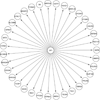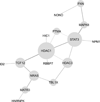MPTP's pathway of toxicity indicates central role of transcription factor SP1
- PMID: 25851821
- PMCID: PMC4415653
- DOI: 10.1007/s00204-015-1509-6
MPTP's pathway of toxicity indicates central role of transcription factor SP1
Abstract
Deriving a Pathway of Toxicity from transcriptomic data remains a challenging task. We explore the use of weighted gene correlation network analysis (WGCNA) to extract an initial network from a small microarray study of MPTP toxicity in mice. Five modules were statistically significant; each module was analyzed for gene signatures in the Chemical and Genetic Perturbation subset of the Molecular Signatures Database as well as for over-represented transcription factor binding sites and WGCNA clustered probes by function and captured pathways relevant to neurodegenerative disorders. The resulting network was analyzed for transcription factor candidates, which were narrowed down via text-mining for relevance to the disease model, and then combined with the large-scale interaction FANTOM4 database to generate a genetic regulatory network. Modules were enriched for transcription factors relevant to Parkinson's disease. Transcription factors significantly improved the number of genes that could be connected in a given component. For each module, the transcription factor that had, by far, the highest number of interactions was SP1, and it also had substantial experimental evidence of interactions. This analysis both captures much of the known biology of MPTP toxicity and suggests several candidates for further study. Furthermore, the analysis strongly suggests that SP1 plays a central role in coordinating the cellular response to MPTP toxicity.
Figures







Comment in
-
From smoking guns to footprints: mining for critical events of toxicity pathways in transcriptome data.Arch Toxicol. 2015 May;89(5):813-7. doi: 10.1007/s00204-015-1497-6. Epub 2015 Apr 8. Arch Toxicol. 2015. PMID: 25851820 Free PMC article. No abstract available.
-
Developing tools for defining and establishing pathways of toxicity.Arch Toxicol. 2015 May;89(5):809-12. doi: 10.1007/s00204-015-1512-y. Epub 2015 Apr 8. Arch Toxicol. 2015. PMID: 25851822 Free PMC article. No abstract available.
Similar articles
-
From smoking guns to footprints: mining for critical events of toxicity pathways in transcriptome data.Arch Toxicol. 2015 May;89(5):813-7. doi: 10.1007/s00204-015-1497-6. Epub 2015 Apr 8. Arch Toxicol. 2015. PMID: 25851820 Free PMC article. No abstract available.
-
Developing tools for defining and establishing pathways of toxicity.Arch Toxicol. 2015 May;89(5):809-12. doi: 10.1007/s00204-015-1512-y. Epub 2015 Apr 8. Arch Toxicol. 2015. PMID: 25851822 Free PMC article. No abstract available.
-
SEA0400, a specific Na+/Ca2+ exchange inhibitor, prevents dopaminergic neurotoxicity in an MPTP mouse model of Parkinson's disease.Neuropharmacology. 2011 Dec;61(8):1441-51. doi: 10.1016/j.neuropharm.2011.08.041. Epub 2011 Sep 2. Neuropharmacology. 2011. PMID: 21903118
-
Attenuation of MPTP-induced neurotoxicity and locomotor dysfunction in Nucling-deficient mice via suppression of the apoptosome pathway.J Neurochem. 2006 May;97(4):1126-35. doi: 10.1111/j.1471-4159.2006.03833.x. J Neurochem. 2006. PMID: 16686692
-
Mechanisms of MPTP toxicity and their implications for therapy of Parkinson's disease.Med Sci Monit. 2005 Jan;11(1):RA17-23. Med Sci Monit. 2005. PMID: 15614202 Review.
Cited by
-
Perspectives on In Vitro to In Vivo Extrapolations.Appl In Vitro Toxicol. 2018 Dec 1;4(4):305-316. doi: 10.1089/aivt.2016.0026. Epub 2018 Dec 8. Appl In Vitro Toxicol. 2018. PMID: 31890748 Free PMC article. Review.
-
Metabolomic network analysis of estrogen-stimulated MCF-7 cells: a comparison of overrepresentation analysis, quantitative enrichment analysis and pathway analysis versus metabolite network analysis.Arch Toxicol. 2017 Jan;91(1):217-230. doi: 10.1007/s00204-016-1695-x. Epub 2016 Apr 2. Arch Toxicol. 2017. PMID: 27039105 Free PMC article.
-
A LUHMES 3D dopaminergic neuronal model for neurotoxicity testing allowing long-term exposure and cellular resilience analysis.Arch Toxicol. 2016 Nov;90(11):2725-2743. doi: 10.1007/s00204-015-1637-z. Epub 2015 Dec 8. Arch Toxicol. 2016. PMID: 26647301 Free PMC article.
-
Avoiding Regrettable Substitutions: Green Toxicology for Sustainable Chemistry.ACS Sustain Chem Eng. 2021 Jun 14;9(23):7749-7758. doi: 10.1021/acssuschemeng.0c09435. Epub 2021 Jun 1. ACS Sustain Chem Eng. 2021. PMID: 36051558 Free PMC article.
-
Identification of transcriptome signatures and biomarkers specific for potential developmental toxicants inhibiting human neural crest cell migration.Arch Toxicol. 2016 Jan;90(1):159-80. doi: 10.1007/s00204-015-1658-7. Epub 2015 Dec 26. Arch Toxicol. 2016. PMID: 26705709 Free PMC article.
References
-
- Cappelletti G, Pedrotti B, Maggioni MG, Maci R. Microtubule assembly is directly affected by MPP(+)in vitro. Cell Biol Int. 2001;25:981–984. - PubMed
-
- Chen S, Lu FF, Seeman P, Liu F. Quantitative proteomic analysis of human substantia nigra in Alzheimer’s Disease, Huntington’s disease and Multiple sclerosis. Neurochem Res. 2012;37:2805–2813. - PubMed
-
- Chuang JY, Wu CH, Lai MD, Chang WC, Hung JJ. Overexpression of Sp1 leads to p53 dependent apoptosis in cancer cells. Int J Cancer. 2009;125:2066–2076. - PubMed
Publication types
MeSH terms
Substances
Grants and funding
LinkOut - more resources
Full Text Sources
Other Literature Sources

